NCERT Exemplar Class 9 Science Chapter 9 Force and Laws of Motion are part of NCERT Exemplar Class 9 Science. Here we have given NCERT Exemplar Class 9 Science Solutions Chapter 9 Force and Laws of Motion.
NCERT Exemplar Class 9 Science Solutions Chapter 9 Force and Laws of Motion
Multiple Choice Questions
Question 1.
Which of the following statement is not correct for an object moving along a straight path in an accelerated motion?
(a) Its speed keeps changing.
(b) Its velocity always changes.
(c) It always goes away from the earth.
(d) A force is always acting on it.
Solution:
(c) An object moving along a straight path in an accelerated motion does not always go away from the earth.
Question 2.
According to the third law of motion, action and reaction
(a) always act on the same body
(b) always act on different bodies in opposite directions
(c) have same magnitude and directions
(d) act on either body at normal to each other.
Solution:
(b) According to the third law of motion, action and reaction always act on different bodies in opposite directions.
Question 3.
A goalkeeper in a game of football pulls his hands backwards after holding the ball shot at the goal. This enables the goal keeper to
(a) exert larger force on the ball
(b) reduce the force exerted by the ball on hands
(c) increase the rate of change of momentum
(d) decrease the rate of change of momentum.
Solution:
(b, d): A goalkeeper in a game of football pulls his hands backwards after holding the ball shot at the goal. This enables the goalkeeper to decrease the rate of change of momentum and hence reduce the force exerted by the ball on hands.
Question 4.
The inertia of an object tends to cause the object
(a) to increase its speed
(b) to decrease its speed
(c) to resist any change in its state of motion
(d) to decelerate due to friction.
Solution:
(c) The inertia of an object tends to cause the object to resist any change in its state of motion.
Question 5.
A passenger in a moving train tosses a coin which falls behind him. it means that motion of the train is
(a) accelerated
(b) uniform
(c) retarded
(d) along circular tracks.
Solution:
(a) As the coin tossed falls behind the passenger, so it means that motion of the train is accelerated.
Question 6.
An object of mass 2 kg is sliding with a constant velocity of 4 m s’1 on a frictionless horizontal table. The force required to keep the object moving with the same velocity is
(a) 32N
(b) 0N
(c) 2N
(d) 8N
Solution:
(b) According to Newton’s first law of motion, an object continues to be in a state of rest or of uniform motion unless acted upon by an unbalanced force. So, there is no requirement of applying force on the object to keep it moving with constant velocity.
Question 7.
Rocket works on the principle of conservation of
(a) mass
(b) energy
(c) momentum
(d) velocity.
Solution:
(c) Rocket works on the principle of conservation of momentum.
Question 8.
A water tanker filled up to – of its height is moving with a uniform speed. On sudden application of the brake, the water in the tank would
(a) move backward
(b) move forward
(c) be unaffected
(d) rise upwards.
Solution:
(b) Due to inertia of motion, the water in the tank would move forward on sudden application of the brake.
Question 9.
There are three solids made up of aluminium, steel and wood, of the same shape and same volume. Which of them would have highest inertia?
Solution:
As the mass is a measure of inertia, the solid of same shape and size having more mass than other solids will have highest inertia. Out of aluminium, steel and wood, density of steel is maximum and hence the mass, therefore, solid made up of steel would have highest inertia.
Question 10.
Two balls of the same size but of different materials, rubber and iron are jcept on the smooth floor of a moving train. The brakes are applied suddenly to stop the train. Will the balls start rolling? If so, in which direction? Will they move with the same speed? Give reasons for your answer.
Solution:
Yes, the balls will start rolling in the direction in which the train was moving. This is because, after applying the brakes, train comes to rest but the balls continue to move due to inertia. Since the masses of the balls are different and hence the inertial forces, the balls will move with different speeds. Iron ball being heavier than the rubber ball will move with lower speed.
Question 11.
Two identical bullets are fired one by a light rifle and another by a heavy rifle with the same force. Which rifle will hurt the shoulder more and why?
Solution:
According to conservation of momentum, momentum of each identical bullet fired is equal to the momentum of light rifle as well as momentum of heavy rifle but in opposite direction. So, the light rifle will recoil faster and hence it will hurt the shoulder more.
Question 12.
A horse continues to apply a force in order to move a cart with a constant speed. Explain why?
Solution:
A horse continues to apply a force so that frictional force between the cart and the ground is overcome and the cart could move with a constant speed.
Question 13.
Suppose a ball of mass m is thrown vertically upward with an initial speed u, its speed decreases continuously till it becomes zero. Thereafter, the ball begins to fall downward and attains the speed u again before striking the ground. It implies that the magnitude of initial and final momentums of the ball are same. Yet, it is not an example of conservation of momentum. Explain why?
Solution:
Law of conservation of momentum is applicable to isolated systems, i.e., systems in which no external force is applied. In the mentioned case, change in velocity is taking place due to gravitational pull of earth only, thus, it is not an example of conservation of momentum.
Question 14.
Velocity versus time graph of a ball of mass 50 g rolling on a concrete floor is shown in Fig. Calculate the acceleration and frictional force of the floor on the ball
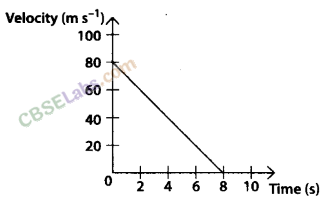
Solution:

Question 15.
A truck of mass M is moved under a force F. If the truck is then loaded with an object equal to the mass of the truck and the driving force is halved, then how does the acceleration change?
Solution:
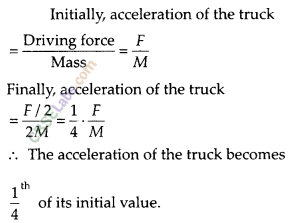
Question 16.
Two friends on roller-skates are standing 5 m apart facing each other. One of them throws a ball of 2 kg towards the other, who catches it, How will this activity affect the position of the two? Explain your answer.
Solution:
Initially, the momentum of both of them is zero. The one who throws the ball will move backward to conserve the momentum imparted on ball. Now, the other one who catches it will also move backward as he will experience a net force after catching the ball. Hence, separation between them will increase.
Question 17.
Water sprinkler used for grass lawns begins to rotate as soon as the water is supplied. Explain the principle on which it works.
Solution:
The rotation of water sprinklers used for grass lawns can be explained on the basis of Newton’s third law of motion. As soon as the water comes out of sprinkler, it exerts an equal and opposite force on the sprinkler and it starts rotating.
Long Answer Type Questions
Question 18.
Using second law of motion, derive the relation between force and acceleration. A bullet of 10 g strikes a sand-bag at a speed of 103 m s’1 and gets embedded after travelling 5 cm. Calculate
(i) the resistive force exerted by the sand on the bullet
(ii) the time taken by the bullet to come to rest.
Solution:
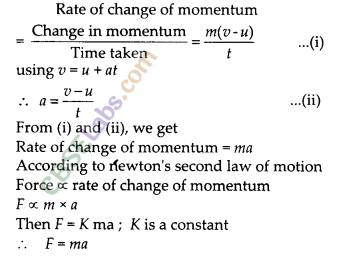
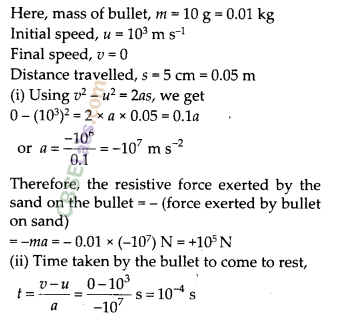
Question 19.
Derive the unit of force using the second law of motion. A force of 5 N produces an acceleration of 8 m s-2 on a mass m and an acceleration of 24 m s-2 on a mass m2. What acceleration would the same force provide if both the masses are tied together?
Solution:

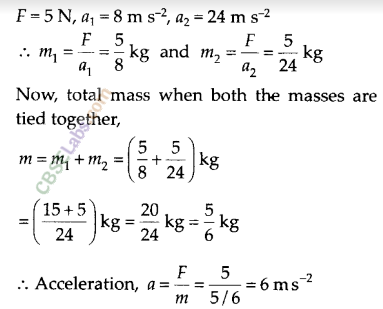
Question 20.
What is momentum? Write its SI unit. Interpret force in terms of momentum. Represent the following graphically
(a) momentum versus velocity when mass is fixed.
(b) momentum versus mass when velocity is constant.
Solution:
Momentum is a property of a moving body by the virtue of both its mass and velocity. It is equal to the product of mass and velocity. p = m × v
Its SI unit is kg ms-1
As momentum = mass x velocity
(a) When mass is fixed,
momentum α velocity
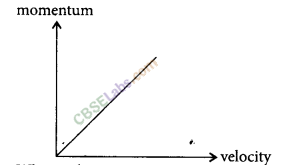
(b) When velocity is constant,
momentum α mass
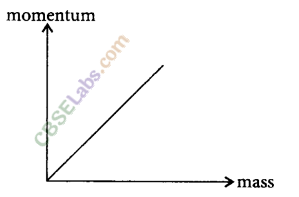
NCERT Exemplar Class 9 Science Solutions
- Chapter 1 Matter In Our Surroundings
- Chapter 2 Is Matter Around Us Pure
- Chapter 3 Atoms and Molecules
- Chapter 4 Structure of the Atom
- Chapter 5 The Fundamental Unit of Life
- Chapter 6 Tissues
- Chapter 7 Diversity in Living Organisms
- Chapter 8 Motion
- Chapter 9 Force and Laws of Motion
- Chapter 10 Gravitation
- Chapter 11 Work and Energy
- Chapter 12 Sound
- Chapter 13 Why do we Fall ill
- Chapter 14 Natural Resources
- Chapter 15 Improvement in Food Resources
We hope the NCERT Exemplar Class 9 Science Chapter 9 Force and Laws of Motionwill help you. If you have any query regarding NCERT Exemplar Class 9 Science Solutions Chapter 9 Force and Laws of Motion, drop a comment below and we will get back to you at the earliest.